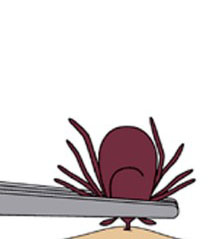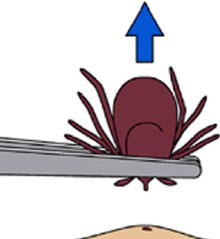The following is from the Center for Disease Control’s website:
- Use fine-tipped tweezers to grasp the tick as close to the skin’s surface as possible.
- Pull upward with steady, even pressure. Don’t twist or jerk the tick; this can cause the mouth-parts to break off and remain in the skin. If this happens, remove the mouth-parts with tweezers. If you are unable to remove the mouth easily with clean tweezers, leave it alone and let the skin heal.
- After removing the tick, thoroughly clean the bite area and your hands with rubbing alcohol, an iodine scrub, or soap and water.


You may have heard of methods such as burning or painting the tick with an irritating substance, but don’t do this because the tick could regurgitate and cause a hypodermic effect in your pet.
Most ticks are relatively harmless in small numbers, but there are a few species that can either cause paralysis or may be carriers of Lyme disease. If you spot ticks on your pet, keep an eye out for signs of muscle weakness. See Lyme Disease and the parasites section for more information. Never ignore a tick, flea, or other parasite on your pet or the situation can quickly get out of hand. Veterinarians have seen cases where dogs and cats have been ridden with hundreds and even thousands of the critters, as they suck the life blood out of the poor animal.